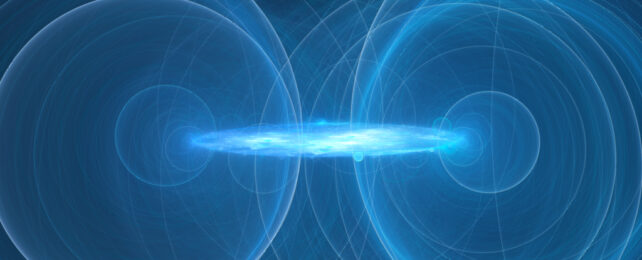For now, dark energy acts as a placeholder for descriptions of the mysterious tide of expansion, inviting all manner of speculation on what the poltergeist in the intergalactic shadows may actually look like.

". . .Naman Kumar, a PhD student at the Indian Institute of Technology, has a few thoughts, which he outlined recently in a pair of published papers. One of his proposals arises from the assumption that our Universe isn't as lonely as it appears. . .
Kumar's version emerges as a consequence of a concept in quantum information theory called relative entropy. Putting it simply, this is a metric that puts a number to differences in distributions of probability across non-symmetrical systems, such as two Universes connected at a point in time.
Should our Universe have roared into existence with a backward-running, charge-flipped, mirror-image 'twin' constrained by the energy conditions of general relativity in the same way ours is, it would be entangled such that each system's energy naturally describes a rapidly expanding radius.
Problem solved, with no dark energy required.
Not satisfied with one bite of the theoretical cherry, Kumar has recently published a second proposal that emerges from hypothetical boundaries between dimensions called branes. By varying the tension in these borders of higher dimensional reality, Kumar shows how spacetime could expand at ever faster rates.
Evoking extra dimensions and mirror Universes to explain something as straightforward as the expansion of the Universe might seem like a stretch, but we may have come to a point in cosmology that we need to consider concepts that challenge our imagination a little. . ."
Should our Universe have roared into existence with a backward-running, charge-flipped, mirror-image 'twin' constrained by the energy conditions of general relativity in the same way ours is, it would be entangled such that each system's energy naturally describes a rapidly expanding radius.
Problem solved, with no dark energy required.
Not satisfied with one bite of the theoretical cherry, Kumar has recently published a second proposal that emerges from hypothetical boundaries between dimensions called branes. By varying the tension in these borders of higher dimensional reality, Kumar shows how spacetime could expand at ever faster rates.
Evoking extra dimensions and mirror Universes to explain something as straightforward as the expansion of the Universe might seem like a stretch, but we may have come to a point in cosmology that we need to consider concepts that challenge our imagination a little. . ."
"After working on the problems of dark matter and dark energy, I can say that either we accept that general relativity is correct and we live in a dark universe with these elusive and peculiar dark matter particles and dark energy, or we accept that we live in a higher dimensional multiverse," Kumar explains in his ScienceX dialog.
This research was published in Gravitation and Cosmology and Europhysics Letters.


No comments:
Post a Comment